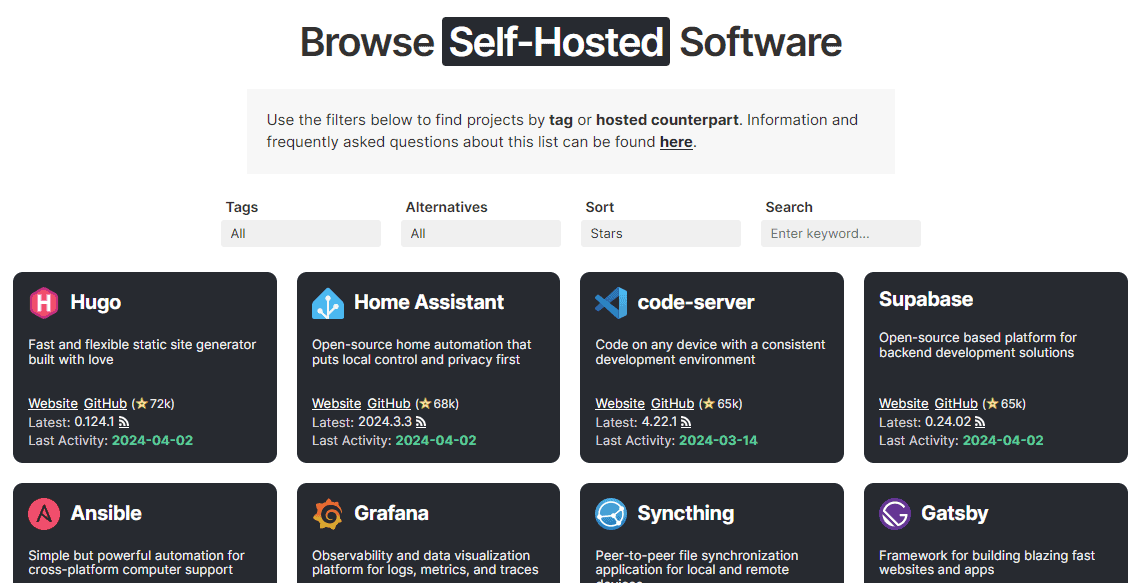FYI, Jenkins has an endpoint to validate the pipeline without running it, and there’s a VSCode extension to do this without leaving the editor: https://www.jenkins.io/blog/2018/11/07/Validate-Jenkinsfile/
- 25 Posts
- 73 Comments
FYI you can (sorta) redirect searches from the start menu: https://www.windowscentral.com/how-let-google-handle-cortana-web-search-results-windows-10
Mine all go to DDG in FF

 3·1 month ago
3·1 month agoThe WinAmp maybe sorta open-sourcing is interesting. I’ve never used it (aside from downloading it to get MilkDrop working in Foobar2000).
I feel the same way. Designing good, opinionated APIs is HARD, but it also provides the best experience for both the author and the consumer.
- Prettier is the undisputed king of JS formatters because it has no options by design. You set and forget.
- One of the reasons iOS is so successful is because they lock down their APIs and put strict standards on apps, making it hard to write something that doesn’t at least look good and slot into the OS well.
Among other examples.
In a world where your IDE and maybe also compiler should warn you about using unicode literals in source code, that’s not much of a concern.
VSCode (and I’m sure other modern IDEs, but haven’t tested) will call out if you’re using a Unicode char that could be confused with a source code symbol (e.g. i and ℹ️, which renders in some fonts as a styled lowercase i without color). I’m sure it does the same on the long equals sign.
Any compiler will complain (usually these days with a decent error message) if someone somehow accidentally inserts an invalid Unicode character instead of typing
==.
These names are really fun! Good ones to add to my list…

 4·2 months ago
4·2 months agoCool to see the Immich team going full time. I don’t use it personally but I hear great things
I have questions. Is this something in use today? Who is manufacturing them? Is this something you’re personally familiar with or just aware of?

 3·2 months ago
3·2 months agoYou mean like
git sparse-checkout? Admittedly experimental but useful
Do you mean admonitions? E.g. info, warning, etc? There’s precedent for that in commonly-used open source implementations, e.g. obsidian.md (which uses the same syntax, and started before). What semantics does it break? It’s designed to read well in plaintext and render nicely even if used in a renderer that doesn’t support admonitions, e.g.
[!NOTE] Information the user should notice even if skimming.
As opposed to other common markdownish implementations that use nonsensical plaintext which renders poorly in alternative renderers. Here’s a discussion on the topic in the CommonMark forums.

 2·3 months ago
2·3 months agoWhat do people have against the Mach kernel?
Actually I’m guessing this is a localization failure

 5·3 months ago
5·3 months ago1 horizontal/1 vertical + laptop.
Horizontal is directly in front of me, used for whatever I’m currently focusing on - usually IDE or browser.
Vertical is to the side, used for anything auxiliary to my current task - browser, bug report, notes, chat, git gui, etc.
Laptop monitor is for anything I want to monitor, but don’t need to look at constantly - logs, news, incoming bug reports, etc.
I also make use of virtual desktops, so I have one for chat/email/general browsing, one for code editing with browser, git gui, IDE, and one for notes/zoom. Laptop screen doesn’t shift with virtual desktops so I always keep the monitoring open.

 5·3 months ago
5·3 months agoAlso, I was just looking this morning at writing something like that Fitbit/influxDB integration for YNAB (You Need a Budget) for visualization in grafana!

 6·3 months ago
6·3 months agoI usually don’t pay much attention to the “new software” section, but PerPlexed looks pretty cool! It never occurred to me that it would be possible to create an alternative Plex UI from scratch like that

 2·3 months ago
2·3 months agoYou should reach out to the authors! I have no clue how they create their “new” section

 4·3 months ago
4·3 months agoAlso, that CLI trick is crazy! Never knew that and I’m a fairly proficient shell user.

 4·3 months ago
4·3 months agoAnyone use authentik? Seems useful, most of my homelab services are unsecured ATM (just local only/vpn)



















I use Jenkins for work, unfortunately, so I have plenty of experience